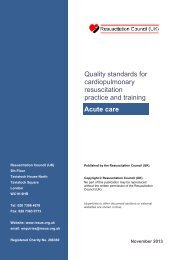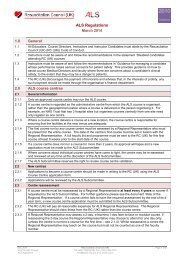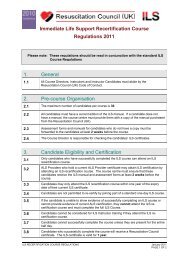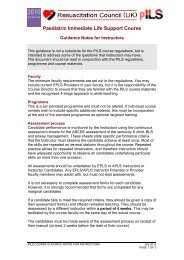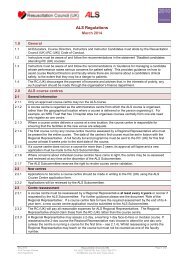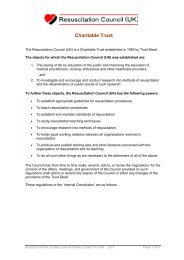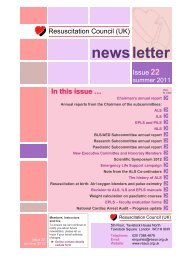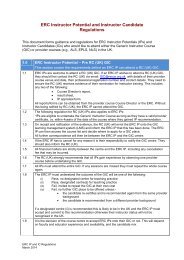Issue 20 - Resuscitation Council (UK)
Issue 20 - Resuscitation Council (UK)
Issue 20 - Resuscitation Council (UK)
You also want an ePaper? Increase the reach of your titles
YUMPU automatically turns print PDFs into web optimized ePapers that Google loves.
<strong>Resuscitation</strong> <strong>Council</strong> (<strong>UK</strong>)<br />
news<br />
letter<br />
In this issue …<br />
Photo previews:<br />
click<br />
to view<br />
full size<br />
HART<br />
in action<br />
group<br />
photo<br />
<strong>Issue</strong> <strong>20</strong><br />
summer <strong>20</strong>10<br />
Chairman’s annual report<br />
Annual reports from<br />
the Chairmen of<br />
the subcommittees:<br />
ALS<br />
ILS<br />
EPLS and PILS<br />
NLS<br />
BLS/AED Subcommittee annual report<br />
Research Subcommittee annual report<br />
Paediatric Committee annual report<br />
New Executive and Honorary Members<br />
Scientific Symposium <strong>20</strong>10<br />
<strong>Resuscitation</strong> Guidelines <strong>20</strong>10<br />
National Cardiac Arrest Audit (NCAA) – Progress update<br />
Hazardous Area Response Teams (HART)<br />
Group photo after <strong>20</strong>10 Annual General Meeting<br />
click<br />
to view<br />
<strong>Issue</strong> <strong>20</strong><br />
summer <strong>20</strong>10<br />
Members, Instructors<br />
and ICs:<br />
To ensure we can continue to<br />
notify you about future<br />
newsletters, please let us<br />
know if your email address<br />
changes.<br />
► Online contact details<br />
update form<br />
<strong>Resuscitation</strong> <strong>Council</strong> (<strong>UK</strong>)<br />
5th Floor, Tavistock House North<br />
Tavistock Square London WC1H 9HR<br />
Telephone: 0<strong>20</strong> 7388 4678<br />
Email: enquiries@resus.org.uk<br />
Website: www.resus.org.uk
From the<br />
Chairman<br />
Chairman’s<br />
annual<br />
report<br />
At the end of my first year as Chair, I am pleased<br />
to report that the RC(<strong>UK</strong>) continues to go from<br />
strength to strength and spread its influence in an<br />
increasing number of areas. This is thanks to the<br />
highly efficient team at the RC(<strong>UK</strong>) and the large<br />
number of individuals who volunteer their time and<br />
effort. Despite the economic downturn, I think the<br />
RC(<strong>UK</strong>) remains in a good position to continue its<br />
important role in delivering high quality<br />
resuscitation guidelines, standards and training<br />
for the benefit of patients.<br />
We are all eagerly looking forward to Guidelines <strong>20</strong>10. The International<br />
Liaison Committee for <strong>Resuscitation</strong> (ILCOR) will publish the Consensus on<br />
Science and Treatment Recommendations (CoSTR) on 18 October <strong>20</strong>10.<br />
The European <strong>Resuscitation</strong> <strong>Council</strong> (ERC) Guidelines based on the ILCOR<br />
CoSTR will be published at the same time. We plan to publish the RC(<strong>UK</strong>)<br />
guidelines shortly after this. We are fortunate to have had a large number of<br />
individuals from the <strong>UK</strong> involved in the ILCOR and ERC guidelines processes.<br />
We will make every effort to ensure that we post updates on the process on our website and<br />
newsletters. The RC(<strong>UK</strong>) Guidelines <strong>20</strong>10 project team chaired by Jerry Nolan will oversee the<br />
process.<br />
The RC(<strong>UK</strong>) continues to spread its influence in a number of areas. This includes working with<br />
NICE as stakeholders, the NHS Litigation Authority about CNST standards, and the Royal<br />
College of Anaesthetists on its continuing professional development matrix and training syllabus.<br />
We have also collaborated with the National Patients Safety Agency (NPSA) on several projects.<br />
David Gabbott has worked with the NPSA to produce a report on incidents in mental health<br />
settings, and commented on rapid response reports on oxygen therapy. We have also reviewed<br />
critical incidents related to resuscitation that have been reported to the NPSA’s national reporting<br />
and learning system (NRLS). I am hoping the information gleaned from the reports will help us<br />
improve resuscitation practice and where possible we can incorporate the key issues in to our<br />
course materials. The <strong>Council</strong> produced guidance for CPR during the swine flu outbreak in<br />
collaboration with the Health Protection Agency. Guidance on Safer Handling was also updated.<br />
We are currently updating the ‘Legal status of those who attempt resuscitation’ document.<br />
The annual symposium at the College of Physicians in London was again well attended. In the<br />
Asmund Laerdal lecture, Bob Bingham reminded us all that when it comes to resuscitation<br />
‘children are different, but they are not a different species’. The <strong>20</strong>10 symposium will be on<br />
18 November. This will be a good opportunity to hear the new guidelines and also find out about<br />
changes to our courses. The guidelines <strong>20</strong>05 meeting was oversubscribed, so book early to<br />
avoid disappointment.<br />
<strong>Issue</strong> <strong>20</strong><br />
summer <strong>20</strong>10<br />
Return to contents page<br />
2
Chairman’s annual<br />
report (continued)<br />
iResus is the new RC(<strong>UK</strong>) iPhone ‘app’. It was<br />
launched at the beginning of the year and enables<br />
rapid access to the latest resuscitation guidelines<br />
and updates. It is free and has so far been<br />
downloaded by over 25,000 users.<br />
The e-ALS study also continues and I thank all those centres involved in recruiting patients. The<br />
Australian <strong>Resuscitation</strong> <strong>Council</strong> has joined the e-ALS project. The experience of the pilot phase<br />
and results of the trial comparing the current ALS course with e-ALS will help with decision<br />
making regarding how the <strong>Resuscitation</strong> <strong>Council</strong> (<strong>UK</strong>) delivers its courses in the future.<br />
The National Cardiac Arrest Audit (NCAA) is now up and running with over 50 hospitals signed up<br />
and the numbers still growing. If your hospital has not yet joined NCAA, I strongly encourage you<br />
to join. Analysis of good quality local and national cardiac arrest data will help us all identify areas<br />
where we can improve the care of patients who need resuscitation.<br />
A brief historical note before I end – CPR celebrates its 50th birthday this year. On 9 July 1960<br />
Kouwenhoven, Jude and Knickerbocker published their landmark paper on chest compressions<br />
and as they say ‘ the rest is history’.<br />
Finally, I would like to thank Sarah Mitchell, Sara Harris, all the RC(<strong>UK</strong>) staff, the Officers, and<br />
members our Committees; these individuals all devote much of their own time to the work of the<br />
<strong>Council</strong> and I am very grateful for their help. The success of the <strong>Council</strong> also depends on the<br />
large number of individuals who help spread our guidelines and teach our courses. Their work<br />
has no doubt saved numerous lives – I would like to thank these individuals on behalf of the<br />
<strong>Resuscitation</strong> <strong>Council</strong> (<strong>UK</strong>).<br />
Jasmeet Soar,<br />
Chairman, <strong>Resuscitation</strong> <strong>Council</strong> (<strong>UK</strong>)<br />
<strong>Issue</strong> <strong>20</strong><br />
summer <strong>20</strong>10<br />
Return to contents page<br />
3
ALS<br />
Subcommittee<br />
annual<br />
report<br />
ALS provider course statistics for <strong>20</strong>09<br />
It has been another successful year for the ALS<br />
Course. Despite concerns with regards to study<br />
leave and professional leave availability, the<br />
number of courses still exceeds 700 and the<br />
number of candidates processed is similar to<br />
previous years. The number of course centres has<br />
reduced compared to last year (274) as the<br />
database has been amended to remove inactive<br />
course centres.<br />
Number of ALS and e-ALS courses 676 + 104 = 780 (745 in <strong>20</strong>08)<br />
Number of Recertification courses 45 (48 in <strong>20</strong>08)<br />
Number of Course Centres 197<br />
New Course Centres 3<br />
Number of candidates 16,422 (16,759 in <strong>20</strong>08)<br />
Number of ALS Instructors 5,945<br />
Number of Instructor Candidates (ICs) 1,501<br />
Projected number of courses for <strong>20</strong>10 567 ALS + 113 e-ALS / 42 Recert<br />
e-ALS<br />
The electronic ALS course project (e-ALS) led by Dr Gavin Perkins (Vice Chair ALS<br />
Subcommittee) is exploring the effectiveness of delivering some of the components of the<br />
traditional ALS Course in an e-learning format thus allowing a reduction in the duration of face-toface<br />
training. The study is randomizing participants to either an e-learning course (1 day<br />
e-learning material and 1 day face-to-face tuition) or traditional ALS course (2 day face- to-face).<br />
The <strong>Resuscitation</strong> <strong>Council</strong> (<strong>UK</strong>) was delighted that the Australian <strong>Resuscitation</strong> <strong>Council</strong> agreed to<br />
join this project late last year and we are looking forward to a successful collaboration. The trial is<br />
on target to complete accrual by the end of September <strong>20</strong>10. We anticipate having the results<br />
ready for presentation at the <strong>Resuscitation</strong> <strong>Council</strong> (<strong>UK</strong>) Scientific Symposium in November <strong>20</strong>10.<br />
Two representatives from each participating centre have been invited to attend the symposium in<br />
order to hear the results of the trial first hand.<br />
I am indebted to Gavin Perkins, Robin Davies, Jenny Lam, Sara Harris and Sarah Mitchell for all<br />
the work they have been putting in behind the scenes to make this project a success.<br />
<strong>Issue</strong> <strong>20</strong><br />
summer <strong>20</strong>10 Return to contents page<br />
4
ALS Subcommittee<br />
annual report<br />
(continued)<br />
Generic instructor course (GIC) statistics for <strong>20</strong>09<br />
Number of GICs 68 (59 in <strong>20</strong>08)<br />
Number of candidates 910 (771 in <strong>20</strong>08)<br />
Number of GIC Course Centres 51<br />
New Course Centres 3<br />
After an extensive period of planning by the Educator Group and a successful pilot period, a new<br />
programme has been developed for the GIC which will be implemented in September. The<br />
principle differences include a different format for feedback and greater emphasis on mentoring<br />
skills. The new course is now ready to be rolled out and I am extremely grateful for the hard work<br />
of all the Educators from the <strong>Resuscitation</strong> <strong>Council</strong> (<strong>UK</strong>) and ALSG under the leadership of Ian<br />
Bullock and Mike Davis.<br />
New ALS course materials<br />
The <strong>20</strong>10 Guidelines are due to be released on 18 October and work is already ongoing to update<br />
the ALS Manual and course materials. We should have all this work completed so that the first<br />
courses can be run in January <strong>20</strong>11. We do not envisage any change to the structure of the<br />
course at this stage. There is no moratorium planned for courses up until this date.<br />
Thanks<br />
The ALS Course could not function without the hard work and dedication of all of the Instructors. It<br />
is becoming increasingly difficult for them to secure time off to teach and yet they continue to do so<br />
to a high standard and I am extremely grateful for this. In addition, we have a strong cadre of<br />
Regional Representatives who also deserve credit for their hard work.<br />
It is with some sadness that I complete this report as it is my last one as ALS Subcommittee Chair.<br />
By the end of the year, I will have completed seven years as Chair including overseeing two sets of<br />
guideline changes. In this time, I have seen the course flourish and the Subcommittee embrace a<br />
proactive approach to technological developments. As always, I must register my grateful thanks<br />
to all members of the ALS Subcommittee. My thanks go also to the course co-ordinators Dami<br />
Daramola and Helen Keen, as well as the administrative staff at the <strong>Resuscitation</strong> <strong>Council</strong> (<strong>UK</strong>).<br />
I am looking forward to fresh challenges within the <strong>Resuscitation</strong> <strong>Council</strong> (<strong>UK</strong>) and will continue to<br />
represent the specialty of Emergency Medicine on the ALS Subcommittee.<br />
Andy Lockey<br />
Chairman, ALS Course Subcommittee<br />
<strong>Issue</strong> <strong>20</strong><br />
summer <strong>20</strong>10<br />
Return to contents page<br />
5
ILS<br />
Subcommittee<br />
annual<br />
report<br />
Course statistics<br />
<strong>20</strong>02 <strong>20</strong>03 <strong>20</strong>04 <strong>20</strong>05 <strong>20</strong>06 <strong>20</strong>07 <strong>20</strong>08 <strong>20</strong>09 <strong>20</strong>10*<br />
Centres 137 160 189 <strong>20</strong>6 219 233 245 247 240<br />
Number of<br />
candidates<br />
ILS<br />
17,281<br />
29,805<br />
37,704<br />
44,733<br />
50,816<br />
56,041<br />
55,851<br />
61,743<br />
21,740<br />
Recertification<br />
127<br />
2,136<br />
4,260<br />
6,895<br />
3,889<br />
6,277<br />
11,383<br />
14,222<br />
5,025<br />
Number of<br />
ILS<br />
courses<br />
Number of<br />
recertification<br />
courses<br />
1,887 3,259 4,260 4,948 5,297 6,047 6,005 6,628 2,289<br />
18 381 714 1,158 553 894 1,538 1,904 676<br />
* <strong>20</strong>10 data based on course returns up to 18 May <strong>20</strong>10<br />
1. The ILS course continued to grow in terms of numbers of candidates.<br />
2. The results of a detailed survey of all course centres in <strong>20</strong>09 will be used to help update<br />
course materials.<br />
3. All course centres have been contacted regarding changes to the faculty regulations<br />
that will be implemented over <strong>20</strong>11/<strong>20</strong>12. All those who teach ILS will have to have<br />
completed either the Generic Instructor Course (GIC) or the ILS instructor course.<br />
4. The continuing success of ILS depends on the hard work of a large number of individuals<br />
whom I wish to thank:<br />
The resuscitation officers, instructors and staff at course centres across the <strong>UK</strong>.<br />
The ILS subcommittee members.<br />
Karla Wright, ILS co-ordinator, and the team in the RC(<strong>UK</strong>) office.<br />
Dr Jasmeet Soar<br />
Chairman, ILS course Subcommittee<br />
<strong>Issue</strong> <strong>20</strong><br />
summer <strong>20</strong>10<br />
Return to contents page<br />
6
EPLS<br />
Subcommittee<br />
annual<br />
report<br />
The courses, EPLS and PILS, continue to go<br />
from strength to strength. As can be seen from<br />
the figures below, the PILS course continues to<br />
increase considerably in terms of popularity.<br />
EPLS<br />
PILS<br />
<strong>20</strong>08 <strong>20</strong>09 <strong>20</strong>08 <strong>20</strong>09<br />
Centres 79 72 132 131<br />
Courses 101 104 810 1185<br />
Cancelled<br />
courses<br />
<strong>20</strong> <strong>20</strong> 0 0<br />
Candidates 2152 2157 7250 9980<br />
… of which:<br />
Doctors 1013 1009 1226 1659<br />
Nurses 917 926 5564 7646<br />
Others 222 222 460 675<br />
The subcommittee has met regularly this last year to consider and begin work on updating the<br />
courses with Guidelines <strong>20</strong>10. The timetable for the incorporation of these new guidelines is that<br />
the new course materials for EPLS and PILS will be with the course centres for courses in May<br />
<strong>20</strong>11.<br />
Work has continued on producing a robust MCQ paper for EPLS – and many thanks are due to<br />
the instructors who have worked hard in sitting the test paper and providing their feedback.<br />
I would like to thank Jackie Younker and John Trounce for their work. They are unable to remain<br />
on the subcommittee due to other commitments. I am delighted that Sophie Skellett, Serena<br />
Cottrell and Liz Norris have joined the subcommittee and I would like to thank them and all the<br />
other members for the enormous amount of their own time they put in to all the projects we<br />
embark upon. And finally, my thanks to Karen Cooper, EPLS co-ordinator, and to Sara Harris<br />
and Sarah Mitchell for their support.<br />
Ian Maconochie<br />
Chairman, EPLS Subcommittee<br />
<strong>Issue</strong> <strong>20</strong><br />
summer <strong>20</strong>10<br />
Return to contents page<br />
7
NLS<br />
Subcommittee<br />
annual<br />
report<br />
The NLS course is well established in the <strong>UK</strong> and<br />
successful completion of a course is expected of all<br />
junior paediatric medical staff during the first two<br />
years of specialisation. Numbers of midwives and<br />
nurses have continued to balance medical staff attending courses. During <strong>20</strong>09 and <strong>20</strong>10 the<br />
number of courses in the <strong>UK</strong> has increased yet again and courses in Europe have continued to<br />
develop. At the present time there are now 90 course centres spread throughout England,<br />
Scotland, Wales and Northern Ireland.<br />
This success since the launch of the NLS course has been due to the work and enthusiasm of<br />
many, but none more than Sam Richmond who in <strong>20</strong>10 has stepped down as chair of the NLS<br />
working group after 8 years. He has chaired the working group from the first pilot courses though<br />
to its present position and will continue as co-author of the <strong>20</strong>10 ERC neonatal guidelines and as<br />
the editor of the next version of the NLS Manual due out early in <strong>20</strong>11. The whole working group<br />
wish to register their thanks for Sam’s leadership, encyclopaedic knowledge of resuscitation<br />
research and almost boundless enthusiasm.<br />
NLS Working Group<br />
With the retirement of Sam Richmond, I have taken over as chair of the working group which has<br />
also welcomed Dr Sean Ainsworth, a neonatologist from Kirkaldy.<br />
Courses held and providers trained<br />
The number of candidates undertaking the NLS course under RC(<strong>UK</strong>) administration has increased<br />
through <strong>20</strong>09 with 4527 candidates attending 223 courses. The proportion of doctors (36.5%),<br />
midwives (30.2%), nurses (30.3%) and allied professions (3%) remained similar to recent years.<br />
The failure rate for candidates attending the course in <strong>20</strong>09 year was 4%. At present there are a<br />
total of 162 course directors, 1114 NLS instructors and 369 instructor candidates in the <strong>UK</strong>. It<br />
would appear that there is still room for growth in NLS courses and places, although the present<br />
financial climate may make it more difficult for midwifery and nursing candidates.<br />
ILCOR <strong>20</strong>10 and Guidelines <strong>20</strong>10<br />
Several members of the working group have been heavily involved in the neonatal subsection of<br />
the ILCOR <strong>20</strong>10 process, culminating in the CoSTR document which will be published in October<br />
<strong>20</strong>10. This document forms the evidential basis for new RC(<strong>UK</strong>) guidelines for newborn<br />
resuscitation which will be published on-line simultaneously. The ERC newborn resuscitation<br />
guidelines will also be published at the same time and the new NLS manual will be available for<br />
courses in May <strong>20</strong>11.<br />
Jonathan Wyllie<br />
Chairman, NLS Course Subcommittee<br />
<strong>Issue</strong> <strong>20</strong><br />
summer <strong>20</strong>10<br />
Return to contents page<br />
8
BLS / AED<br />
Subcommittee<br />
annual<br />
report<br />
The Subcommittee met face-to-face on two<br />
occasions over the year.<br />
Changes in membership<br />
Two members, Mary Richardson and Dr Richard Elliott, have resigned for work-related reasons.<br />
Dr Mick Colquhoun has taken on the role of Deputy Chairman.<br />
Discussions and statements<br />
The statement on ‘Training required to use an AED’ was reviewed, and additional wording<br />
recommended. The revised statement is on the <strong>Council</strong> web site.<br />
Considerable discussion has taken place regarding the statement ‘Legal status of those who<br />
provide CPR’ with input from the <strong>Council</strong>’s solicitor. The work is ongoing, but it is anticipated that<br />
the final draft will be ready shortly for approval by the Executive Committee.<br />
The Subcommittee agreed a statement on ‘Swine flu: first aid advice on cardiopulmonary<br />
resuscitation’ to supplement the <strong>Council</strong>’s statement on swine flu, which is aimed mainly at the inhospital<br />
/ ALS environment.<br />
The <strong>Council</strong> received an enquiry about AEDs being kept in locked cabinets. The Subcommittee<br />
recommended that AEDs should be readily accessible and well-signed. Following contact with the<br />
BHF, a statement is now on the <strong>Council</strong>’s web site.<br />
Following a specific enquiry on how to manage a patient who vomits (regurgitates) during CPR, the<br />
Chairman presented the advice contained in the RLSS <strong>UK</strong> publication. This will now form the<br />
formal recommendation of the Subcommittee.<br />
Guidelines <strong>20</strong>10<br />
A number of topics, not covered by the current RC(<strong>UK</strong>) BLS/AED guidelines, have been identified,<br />
and will be considered for inclusion in the forthcoming <strong>20</strong>10 guidelines. These topics include:<br />
What to do if the patient vomits; how to resuscitate obese or pregnant patients; defibrillation on wet<br />
or metal surfaces; storage of AEDs; AED signage; who can use an AED; risk assessment and<br />
cost-effectiveness when deciding if an AED is required.<br />
<strong>Issue</strong> <strong>20</strong><br />
summer <strong>20</strong>10<br />
Return to contents page 9
BLS/AED<br />
Subcommittee<br />
annual report<br />
(continued)<br />
Future work<br />
The following tasks have been identified as priorities:<br />
1. Interpret guideline changes and advise on implementation<br />
2. Promote awareness of guideline changes and their dissemination<br />
3. Answer enquiries relating to adult BLS and use of an AED<br />
4. Liaise with ERC, ILCOR, and national and international organisations involved in<br />
BLS/AED training<br />
5. Support the national database on AEDs<br />
6. Provide an RC(<strong>UK</strong>) CPR/AED training manual, syllabus, and competences.<br />
Anthony J Handley<br />
Chairman, BLS/AED Subcommittee<br />
Research<br />
Subcommittee<br />
annual<br />
report<br />
This is the report of the Research subcommittee for the year <strong>20</strong>09 - <strong>20</strong>10. The <strong>Resuscitation</strong><br />
<strong>Council</strong> (<strong>UK</strong>) has always supported research into the science of resuscitation and in order to further<br />
these aims, the Research subcommittee considers all reasonable and appropriate applications for<br />
research funding in this area. We have a yearly budget for both Grants and Fellowship awards.<br />
This last financial year the Research subcommittee budget was £150,000 which was made<br />
generally available to support external Grant and Fellowship awards. The <strong>Resuscitation</strong> <strong>Council</strong><br />
(<strong>UK</strong>) continues to meet the criteria for NIHR Partner Organisation status.<br />
During <strong>20</strong>09 - <strong>20</strong>10 the subcommittee has dealt with all its matters via the telephone and<br />
electronically. The pages on the <strong>Resuscitation</strong> <strong>Council</strong> (<strong>UK</strong>) website have been updated. We have<br />
offered advice to potential applicants throughout this time and we have formally considered seven<br />
applications during this financial year.<br />
<strong>Issue</strong> <strong>20</strong><br />
summer <strong>20</strong>10<br />
Return to contents page<br />
10
Research<br />
Subcommittee<br />
annual report<br />
(continued)<br />
NCAA (National Cardiac Arrest Audit)<br />
RC(<strong>UK</strong>) continues to jointly fund this project with ICNARC and significant progress has been made<br />
in <strong>20</strong>09/10. The two organisations have collaborated to develop a nationwide database of cardiac<br />
arrests that take place in hospital. The project went live this financial year and as of April <strong>20</strong>10<br />
over 50 hospitals have signed up. The aim is to enable analysis of all in-hospital cardiac arrests<br />
and to compare the frequency of, and outcome from, cardiac arrest between hospitals.<br />
The <strong>Council</strong> continues to fund and oversee the national Automated External Defibrillator Event<br />
database which logs the outcomes following resuscitation attempts by lay people. This project is in<br />
collaboration with the Department of Health and the British Heart Foundation.<br />
iResus Application for the iPhone<br />
RC(<strong>UK</strong>) has funded the development and launch of this resuscitation application in conjunction with<br />
iMobileMedic for the iPhone. The application is free and will be continuously updated and<br />
expanded. To date there have been over 25,000 downloads.<br />
The Research subcommittee is keen to support future projects and would welcome applications for<br />
research funds for the current financial year. We are also happy to advise prospective applicants<br />
prior to making a formal application for funds as to whether their application is appropriate.<br />
Scientific Symposium<br />
Research abstracts for the <strong>20</strong>10 Annual Scientific Symposium on 18 November must be submitted<br />
by 31 August, <strong>20</strong>10 – full details are on the website. This is a great opportunity for presenting new<br />
research or preliminary data to a large audience of interested resuscitation enthusiasts. This year<br />
as well as the best 5 oral presentations we will be accepting posters for presentation at the<br />
meeting.<br />
Once again I would like to thank all the Research subcommittee members for their time throughout<br />
the year, Sara Harris in particular for all her hard work and support and Sarah Mitchell for her<br />
invaluable advice.<br />
David Gabbott<br />
Chairman, Research Subcommittee<br />
<strong>Issue</strong> <strong>20</strong><br />
summer <strong>20</strong>10<br />
Return to contents page<br />
11
Membership:<br />
Paediatric<br />
Committee<br />
annual<br />
report<br />
Name<br />
Bob Bingham (Chair)<br />
Serena Cottrell<br />
Peter Mark-Fortune<br />
Fiona Jewkes<br />
Ian Maconochie<br />
Sheila Simpson<br />
Jonathan Wyllie<br />
David Zideman<br />
Representing<br />
Paediatric anaesthesia<br />
Paediatric intensive care<br />
Paediatric intensive care<br />
Pre-hospital care<br />
Paediatric emergency medicine<br />
Paediatric nursing and ROs<br />
Neonatal resuscitation<br />
Paediatric anaesthesia and Olympic sport!<br />
The main duty of the paediatric committee is to ensure that the <strong>Council</strong> fully considers the needs<br />
of children in the conduct of its business. The committee offers advice, prepares statements and<br />
answers questions on paediatric matters addressed to the <strong>Council</strong>.<br />
Activities<br />
In the last year, committee members have been primarily involved in the preparation of guideline<br />
and educational materials for the release of Guidelines <strong>20</strong>10. David Zideman, Ian Maconochie,<br />
Bob Bingham and Jonathan Wyllie have conducted ILCOR worksheet reviews and were present<br />
at the consensus conference in Dallas and participated in the preparation of the Consensus on<br />
Science and Treatment Recommendations (CoSTR). These members have also been involved<br />
in the writing of the ERC guidelines.<br />
Fiona Jewkes and David Zideman have been preparing statements to provide answers to FAQs,<br />
which may arise from the release of Guidelines <strong>20</strong>10. Serena Cottrell and Peter Mark-Fortune<br />
have contributed to the discussion over the paediatric content of the DNAR document and a<br />
paediatric statement and form has been included. Bob Bingham has been attending the NCAA<br />
meetings to provide paediatric input into the audit.<br />
A list of research questions, which the committee considers a priority, is also being prepared. It<br />
is envisaged that this will eventually form a resource for potential researchers and a guide for<br />
review of grant applications.<br />
As mentioned in the EPLS course subcommittee report, preparations for the revision of the <strong>UK</strong><br />
EPLS and NLS course materials are well under way and members of the paediatric<br />
subcommittee, particularly Ian Maconochie, Sheila Simpson and Jonathan Wyllie are fully<br />
involved.<br />
Bob Bingham<br />
Chairman, Paediatric Committee<br />
<strong>Issue</strong> <strong>20</strong><br />
summer <strong>20</strong>10<br />
Return to contents page<br />
12
New Executive<br />
and Honorary<br />
Members<br />
At the annual general meeting Jerry Nolan’s tenure as Vice Chairman was complete and he was<br />
re-elected as a member of the Executive. David Pitcher was elected Vice-Chairman (Chairmanelect)<br />
and will become Chairman of the <strong>Resuscitation</strong> <strong>Council</strong> (<strong>UK</strong>) in June <strong>20</strong>12. Andy Lockey<br />
was elected Honorary Secretary. Jamie Fulton was elected as a new member of the Executive.<br />
Four members were nominated for Honorary membership: Dr Andrew Marsden, Dr Jerry<br />
Nolan, Dr Robert Bingham, and Dr Sam Richmond. Jas Soar recommended all as highly<br />
deserving of the nomination for their invaluable contributions to the <strong>Resuscitation</strong> <strong>Council</strong> (<strong>UK</strong>).<br />
These nominations had been approved by the Executive and were ratified at the AGM.<br />
Scientific<br />
<strong>20</strong>10 Symposium<br />
View the group photo<br />
taken after the AGM<br />
Click here<br />
The Scientific Symposium meeting is on Thursday 18 November at the National Motorcycle<br />
Museum, Solihull.<br />
At this meeting the new guidelines and the science will be presented. The full programme is<br />
available on our website. Six hundred delegates have already registered and we will be closing<br />
registration soon.<br />
Presentation of Free Papers and Posters<br />
LAST CALL<br />
This year’s presentations can be presented either as an oral presentation or as a poster. The<br />
Research Subcommittee will decide which presentations will be oral and which will be posters<br />
(unless you express your wish not to present orally). If you would like the opportunity to present<br />
at the Symposium please submit your application no later than 31 August. Full details and an<br />
application form can be downloaded from the website. Please return your application to Sara<br />
Harris at sara.harris@resus.org.uk<br />
<strong>Issue</strong> <strong>20</strong><br />
summer <strong>20</strong>10<br />
Return to contents page<br />
13
<strong>Resuscitation</strong><br />
<strong>20</strong>10 Guidelines<br />
A Guidelines <strong>20</strong>10 project team, chaired by Jerry Nolan, was set up last year to look at implementing<br />
the new guidelines and producing updated course materials. Our aim is to deliver the guidelines<br />
quickly, without confusion, and to disseminate the course material in a timely manner. The new<br />
guidelines will be published on our website on 18 October <strong>20</strong>10.<br />
The <strong>Resuscitation</strong> <strong>Council</strong> (<strong>UK</strong>) is not imposing a moratorium on its courses; it is in the best interests<br />
of healthcare staff and patients that centres continue providing training right up until the new material<br />
is available. This strategy worked well in <strong>20</strong>05. We have been in discussion with the NPSA on<br />
implementation, and have written to all Trusts and instructors, and other relevant organisations to<br />
keep them informed.<br />
We are aiming that the first of each of the new courses shall be held as follows:<br />
ALS and ILS January <strong>20</strong>11<br />
EPLS and PILS May <strong>20</strong>11<br />
NLS May <strong>20</strong>11<br />
The RC(<strong>UK</strong>) has not increased its registration costs since 1998. As the new courses are introduced<br />
the price of the course ALS/EPLS and NLS manuals will increase by £3 each and each candidate<br />
registration will increase by £2. The GIC registration will also increase to £22 in January <strong>20</strong>11.<br />
There is no increase in the cost of annual registration for PILS and ILS although the manuals will<br />
increase by 50 pence each. Instructors and Instructor candidates will be invited to apply on line to<br />
receive a complimentary copy of new course manuals.<br />
National<br />
Cardiac<br />
Arrest<br />
Audit (NCAA) Progress update 4<br />
NCAA is a joint initiative between the <strong>Resuscitation</strong> <strong>Council</strong> (<strong>UK</strong>) and ICNARC (Intensive Care<br />
National Audit & Research Centre) to establish an audit of in-hospital cardiac arrests with a view<br />
to improving resuscitation care and patient outcomes.<br />
Since NCAA began in September <strong>20</strong>09, a total of 60 hospitals have signed up to participate.<br />
A list of these hospitals is available to download from the ICNARC website (www.icnarc.org).<br />
Follow the quick link ‘National Cardiac Arrest Audit (NCAA)’.<br />
Recruitment is ongoing so if your hospital would like more information about the audit please<br />
contact the NCAA Team on ncaa@icnarc.org<br />
<strong>Issue</strong> <strong>20</strong><br />
summer <strong>20</strong>10<br />
Return to contents page<br />
15 14
National Cardiac<br />
Arrest Audit (NCAR)<br />
Progress update<br />
(continued)<br />
First NCAA Participants Meeting - 28 June <strong>20</strong>10<br />
The First NCAA Participants Meeting was held on 28 June in London and was attended by 34<br />
delegates from 29 participating hospitals. This was a great turnout with over half of all hospitals<br />
signed up to NCAA represented. Those attending contributed to the informal and interactive<br />
discussions around the initial scope for NCAA data collection, the current Level A dataset and the<br />
development of NCAA reports. Many thanks to all delegates who attended the meeting and<br />
participated in all of the discussions.<br />
Two members of the NCAA Steering Group; Jerry Nolan (NCAA Steering Group Chair) and Sarah<br />
Mitchell (Director, <strong>Resuscitation</strong> <strong>Council</strong> (<strong>UK</strong>)) also attended the meeting as well as the NCAA Team<br />
from ICNARC.<br />
To facilitate discussions around the development of NCAA reports, some early NCAA analyses were<br />
shared with the group. Those attending were very helpful in contributing their ideas for what they<br />
would like to see in the reports.<br />
Evaluation Forms and post-event feedback indicated that delegates found it to be a useful and<br />
informative meeting.<br />
Current focus<br />
The NCAA Team are currently focusing on data validation and the development of an NCAA Data<br />
Validation Report. This report will inform hospitals about the timeliness of their data entry and the<br />
completeness and validity of their NCAA data, and will help improve the quality of NCAA data. We<br />
will be providing each participating hospital with an NCAA Data Validation Report as soon as<br />
possible.<br />
The current target for the provision of NCAA Activity Reports is by the end of October <strong>20</strong>10. It is<br />
hoped that comparative reports will be available by the end of the year.<br />
New developments<br />
The Level A dataset is being reviewed. All participants will be informed of the minor changes to the<br />
dataset in due course.<br />
Date for your diary – NCAA Launch<br />
The Second NCAA Participants Meeting and official NCAA Launch and will be held on Monday,<br />
4 October <strong>20</strong>10 in Central London. More details for these events will be circulated in due course.<br />
Sarah Mitchell Kathy Rowan Edel Gallagher<br />
Director Director NCAA Coordinator<br />
<strong>Resuscitation</strong> <strong>Council</strong> (<strong>UK</strong>) ICNARC ICNARC<br />
<strong>Issue</strong> <strong>20</strong><br />
summer <strong>20</strong>10<br />
Return to contents page<br />
15
Hazardous Area<br />
Response Teams<br />
(HART)<br />
The provision of pre-hospital emergency medical care is never more challenging than in confined<br />
spaces or contaminated areas. Clearly these situations put staff at significant risk and the general<br />
aim is therefore to remove the patient from the hazardous environment prior to treating them.<br />
Traditionally the Ambulance Service had always operated within the ‘cold zone’ of an incident; an<br />
area free from contamination and deemed to be a safe working environment. The immediate<br />
responsibility for extracting patients from the inner cordon (also known as ‘the hot zone’) of a major<br />
hazardous incident has fallen to the fire service who are trained and equipped to work in these<br />
environments.<br />
With the limited clinical skills that could be provided with this arrangement, it was recognized that<br />
there was a need to look at providing more advanced medical care during the early stages of a<br />
hazardous incident, particularly if the patient was trapped or extrication was delayed. A number of<br />
recent major incidents, together with an increasing threat of a chemical, biological, radiological or<br />
nuclear (CBRN) incident reinforced the need to look at delivering advanced medical care in more<br />
hazardous environments.<br />
About ten years ago, ambulance services had recognized the need to move clinical care further<br />
forward, and began to train and equip staff to work within a ‘warm zone’ environment, to assist with<br />
immediate medical care and the provision of decontamination to casualties and emergency service<br />
workers.<br />
In <strong>20</strong>04, the Department of Health approached the Ambulance Service Association (ASA) to look<br />
into the feasibility of moving clinical care a step nearer to the core of the incident, with ambulance<br />
personnel working alongside other emergency personnel in the ‘hot zone’ of a major hazardous<br />
incident. The following year, experts from <strong>UK</strong> ambulance services, doctors and CBRN specialists<br />
reported that not being able to deliver advanced clinical care in the ‘hot zone’ of a major incident<br />
was likely to result in an impeded effective ambulance response with an inability to undertake life<br />
saving interventions at the early stages of a CBRN or hazardous material (HAZMAT) incident.<br />
The need to introduce ‘hot zone’ working was reinforced by the subsequent terrorist bombings in<br />
London on 7 July <strong>20</strong>05 that demonstrated the life-saving benefits of delivering immediate medical<br />
care in a potentially hazardous environment to patients who were trapped in wreckage.<br />
As a result of the recognized need to deliver clinical care within the ‘hot zone’, the Hazardous Area<br />
Response Team (HART) programme was born which aims to train and equip ambulance<br />
personnel to work safely in contaminated environments or in the presence of serious hazards such<br />
as collapsed structures. Shortly after HART’s inception, the Department of Health was<br />
approached by the Fire and Rescue Service with a request to provide trained paramedics for their<br />
Urban Search and Rescue (USAR) teams. In <strong>20</strong>06, it was therefore decided to add a USAR<br />
capability to the HART project.<br />
<strong>Issue</strong> <strong>20</strong><br />
summer <strong>20</strong>10<br />
Return to contents page<br />
16
Hazardous Area<br />
Response Teams<br />
(HART)<br />
(continued)<br />
Within the HART programme, there are two components:<br />
<br />
HART IRU (Incident Response Unit)<br />
The Incident Response Unit provides a team trained to work in HAZMAT and CBRN<br />
environments to support other emergency services and other specialist agencies, and<br />
deliver clinical care in the ‘hot zone’ of an incident. These teams are able to work in<br />
accidental incidents or those involving deliberate harm, e.g. terrorist attacks. Typical<br />
events attended by the HART IRU would include a chemical explosion at a factory, large<br />
fires, explosions or a suspected terrorist attack. The HART IRU can also provide support<br />
for the military (within England) and assist the police with medical support for covert<br />
operations.<br />
<br />
HART USAR (Urban Search and Rescue)<br />
HART USAR paramedics are trained to work in dangerous and hazardous environments<br />
such as collapsed buildings or crashed vehicles. HART USAR paramedics are taught<br />
extended clinical skills which enable them to provide advanced clinical intervention during<br />
the rescue of casualties from these environments. HART USAR teams would typically<br />
work at incidents that involve collapsed buildings or structures (e.g. scaffolding), in<br />
tunnels, such as a major evacuation of a tube train, heavy transportation or multiple<br />
vehicle collisions resulting in a number of casualties or at height, e.g. on construction<br />
sites.<br />
Eventually it is anticipated that other specialist groups, such as the Maritime Incident Response<br />
Group (MIRG) will also be incorporated into HART.<br />
HART training<br />
The paramedics selected for these teams are required to pass additional fitness and aptitude<br />
tests before undertaking a rigorous training programming involving all aspects of safe working in<br />
HAZMAT and CBRN incidents. When not working on a HART mission, these paramedics are<br />
integrated into the normal ambulance service response.<br />
<strong>Issue</strong> <strong>20</strong><br />
summer <strong>20</strong>10<br />
Return to contents page<br />
17
Hazardous Area<br />
Response Teams<br />
(HART)<br />
(continued)<br />
HART training session<br />
HART Roll-out<br />
HART are being rolled out across all <strong>UK</strong> Ambulance Trusts, with 12 bases being established in<br />
England, with similar capabilities being established in Scotland, Wales and Northern Ireland. The<br />
London HART teams have been established for several years and all English teams are planned<br />
to be fully operational by April <strong>20</strong>11. Each Ambulance Trust has access to a 24/7 response that<br />
can be backed up with further resources through mutual aid arrangements from neighbouring<br />
Trusts.<br />
Charles Deakin<br />
<strong>Issue</strong> <strong>20</strong><br />
summer <strong>20</strong>10<br />
Return to contents page<br />
18
Group photo<br />
after the <strong>20</strong>10<br />
Annual General Meeting<br />
Members of the Executive Committee, Subcommittees and RC(<strong>UK</strong>) staff after the <strong>20</strong>10 Annual<br />
General Meeting.<br />
In this photo (left to right):<br />
Dr James Fullerton, Dami Daramola (staff), Dr Harry Walmsley (Honorary Treasurer), Dr Jamie<br />
Fulton (Executive Committee), Dr Anthony Handley (Company Secretary, Chairman, BLS/AED<br />
Sub-Committee), Dr Mick Colquhoun (Executive Committee), Dr Fiona Jewkes (Executive<br />
Committee), Dr David Gabbott (Chairman, Research Sub-Committee), Dr Jasmeet Soar<br />
(Chairman, Chairman, ILS Course Sub-Committee), Dr Charles Deakin (Executive Committee),<br />
Dr Carl Gwinnutt (Executive Committee), Sarah Mitchell (Director <strong>Resuscitation</strong> <strong>Council</strong> (<strong>UK</strong>)), Dr<br />
Kin Leong Kong (Executive Committee), Dr David Pitcher (Vice Chairman), Dr Serena Cottrell<br />
(Executive Committee), Dr Andy Lockey (Honorary Secretary, Chairman, ALS Course Sub-<br />
Committee), Sara Harris (staff), Dr Jerry Nolan (Executive Committee), Susan Hampshire<br />
(Executive Committee) Dr Peter-Marc Fortune (Executive Committee), Jonathan Wyllie<br />
(Chairman, NLS Course Sub-Committee), Dr Bob Bingham (Chair, Paediatric Committee), Jenny<br />
Lam (staff), Linda Steel (staff), Dr Ian Maconochie (Chairman, EPLS Course Sub-Committee),<br />
Bob Harris (staff).<br />
Let us know what you think:<br />
If you have any comments regarding this newsletter, please<br />
contact us at enquiries@resus.org.uk<br />
<strong>Issue</strong> <strong>20</strong><br />
summer <strong>20</strong>10<br />
Return to contents page<br />
19



